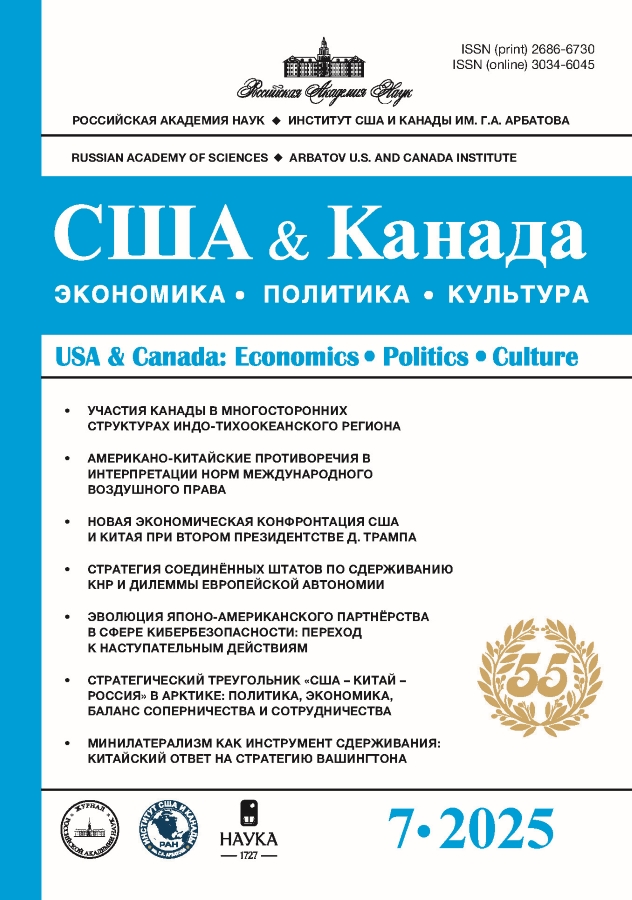Chinese Investments in the United States in the Context of U.S.–China Rivalry
- Authors: Khoroshilov E.E1
-
Affiliations:
- Georgy Arbatov Institute for U.S. and Canada Studies, Russian Academy of Sciences (ISKRAN)
- Issue: No 7 (2025)
- Pages: 80-93
- Section: Economics
- URL: https://rjdentistry.com/2686-6730/article/view/692530
- DOI: https://doi.org/10.31857/S2686673025070082
- ID: 692530
Cite item
Abstract
In the context of escalating U.S.–China tensions, China's technological breakthrough, the huge negative balance of bilateral trade, and the growth of Chinese investments abroad are of particular concern to the United States. Washington views China's transformation into one of the world's leading capital exporters as a serious threat. The export of foreign direct investments allows China to access advanced technologies, gain control over strategically important mineral reserves and infrastructure projects in other countries, and strengthen its political influence in various regions of the world. Regarding Chinese capital exports to the United States, the growing rivalry between Washington and Beijing is reflected in several key trends. First, there has been a sharp reduction in Chinese investments in American government securities, as China's trust in them has been undermined. Second, there is a gradual decrease in Chinese direct investment in the United States. On the one hand, this results from Washington's treats investments from China with growing suspicion and is increasingly inclined to restrict them for reasons of national security. On the other hand, these investments are becoming less attractive for the Chinese government and investors due to increased political risks. All this taken together, along with the decline in China's share in American foreign trade, indicates a fairly intensive process of decoupling of the American and Chinese economies. In addition, with regard to investments from China, the United States seeks to extend its jurisdiction to third countries, preventing expansion of Chinese capital abroad, especially in such areas as high technology, mining of critical minerals and infrastructure.
Keywords
About the authors
E. E Khoroshilov
Georgy Arbatov Institute for U.S. and Canada Studies, Russian Academy of Sciences (ISKRAN)
Email: eu.khoroshilov@iskran.ru
ORCID iD: 0000-0002-3738-9035
Head, Department of Economic Studies; Candidate of Sciences (Economics) Moscow, Russian Federation
References
- Balance of Payments and Direct Investment Position Data. Foreign Direct Investment in the U.S., Foreign Direct Investment Position in the United States on a Historical-Cost Basis. By Country and Industry (NAICS) (Millions of Dollars). Bureau of Economic Analysis. Available at: https://apps.bea.gov/iTable/?reqid=2 (accessed 04.04.2025).
- Table 1. U.S. International Trade by Selected Countries and Areas. Bureau of Economic Analysis. Available at: https://www.bea.gov/sites/default/files/2025-03/trad-geo-time-series0125.xlsx (accessed 03.04.2025).
- China Restricts Companies from Investing in US as Tensions Rise. Bloomberg. 02.04.2025. Available at: https://www.bloomberg.com/news/articles/2025-04-02/china-restricts-companies-from-investing-in-us-as-tensions-rise (accessed 04.04.2025).
- China’s External Portfolio Investment Assets. China State Administration of Foreign Exchange. Available at: https://www.safe.gov.cn/en/ChinasExternalPortfolioInvestm/index.html (accessed 04.04.2025).
- China's central bank ups gold reserves for fourth straight month in February. Reuters, 07.03.2025. Available at: https://www.reuters.com/world/china/chinas-central-bank-upsgold-reserves-fourth-straight-month-february-2025-03-07/ (accessed on 04.04.2025).
- Coordinated Portfolio Investment Survey. Table 8: Derived Portfolio Investment Liabilities (All Economies) by Economy of Nonresident Holder: Total Portfolio Investment (Derived from Creditor Data). International Monetary Fund. IMF Data. Available at: https://data.imf.org/regular.aspx?key=60587812 (accessed 13.03.2025).
- External Sector. International Monetary Fund. IMF Data. Available at: https://data.imf.org/regular.aspx?key=63087879 (accessed 18.03.2025).
- External Sector. Financial Account, Net Lending (+) / Net Borrowing (-) (Balance from Financial Account), Direct Investment, Net Acquisition of Financial Assets, US Dollars. International Monetary Fund. IMF Data. Available at: https://data.imf.org/regular.aspx?key=63087879 (accessed 18.03.2025).
- External Sector. Financial Account, Portfolio Investment, Net Acquisition of Financial Assets, US Dollars. International Monetary Fund. IMF Data. Available at: https://data.imf.org/regular.aspx?key=63087879 (accessed 18.03.2025).
- China Statistical Yearbook 2024. Table 11-19: Outward Foreign Direct Investment by Country (Region). National Bureau of Statistics of China. Available at: https://www.stats.gov.cn/sj/ndsj/2024/indexeh.htm (accessed 04.04.2025).
- Fact Sheet: President Donald J. Trump Encourages Foreign Investment While Protecting National Security. 21.02.2025. The White House. Available at: https://www.whitehouse.gov/factsheets/2025/02/fact-sheet-president-donald-j-trump-encourages-foreign-investment-whileprotecting-national-security/ (accessed 04.04.2025).
- Securities (B): Portfolio Holdings of U.S. and Foreign Securities. MFH-history tables; Major Foreign Holders of U.S. Treasury Securities (MFH table). U.S. Department of the Treasury. Available at: https://ticdata.treasury.gov/resource-center/data-chart-center/tic/Documents/mfhhis01.txt (accessed 03.04.2025).
- Data Hub. Foreign direct investment: Inward and outward flows and stock, annual. United Nations Conference on Trade and Development. Available at: https://unctadstat.unctad.org/datacentre/dataviewer/US.FdiFlowsStock (accessed 04.04.2025).
- World Development Indicators. Total reserves (includes gold, current US$). World Bank. Available at: https://data.worldbank.org/indicator/FI.RES.TOTL.CD (accessed 04.04.2025).
- WTO Stats. World Trade Organization. Available at: https://stats.wto.org/ (accessed 03.04.2025).
- Дмитриев С.С. Американо-китайские внешнеэкономические связи на этапе «частичного разъединения». США & Канада: экономика, политика, культура. 2023. № 53(8). С. 69–79. DOI: https://doi.org/10.31857/S2686673023080072.
- Лебедева Л.Ф., Антипин С.А., Чжан Д.Ю. Прямые иностранные инвестиции в обрабатывающей промышленности США. Международная торговля и торговая политика. 2015. № 3(3). С. 52–65.
- Лосева А.В. Статистический анализ закономерностей развития мировых инвестиций Китая. Статистика и Экономика. 2022. Т. 19. № 3. С. 4–14. DOI: https://doi.org/10.21686/2500-3925-2022-3-4-14.
- Петров М.В. Влияние геополитической напряженности на международное движение капитала. Финансовый журнал. 2024. Т. 16. № 3. С. 8–22. doi: 10.31107/2075-1990-2024-3-8-22.
- Сизых Е.Ю. Экспорт прямых иностранных инвестиций из КНР: глобальные тренды и новая старая нормальность. Российско-китайские исследования. 2020. Т. 4. № 4. С. 288–298. DOI: https://doi.org/10.17150/2587-7445.2020.4(4).288-298.
- Супян В.Б. Насколько сильна экономика США. Монокль. 2025. № 13. C. 58–62. Available at: https://monocle.ru/monocle/2025/13/naskolko-silna-ekonomika-ssha/amp/ (accessed 03.04.2025).
- Труш С.М. Политика Д. Трампа в отношении Китая: мотивация, эволюция, итоги. Российское китаеведение. 2023. № 3(4). С. 69–92. DOI: https://doi.org/10.48647/ICCA.2023.60.79.005.
Supplementary files











